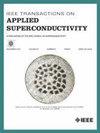The Radial Flux HTS Synchronous Motor Stator Windings Comparison for Electrified Aircraft Applications
IF 1.7
3区 物理与天体物理
Q3 ENGINEERING, ELECTRICAL & ELECTRONIC
引用次数: 0
Abstract
Electrified aircraft propulsion systems could be a key solution for achieving zero-emission aviation. The need for efficient multi-megawatt motors with high power density makes superconducting motors a promising solution. This study investigates the performance of radial flux high-temperature superconductor (HTS) synchronous motors for electrified aircraft applications, emphasizing the impact of stator windings on power density and losses. In this study, two motor benchmarks of 450 kW and 1 MW are proposed, the impact of an iron core on the stator structure is analyzed, and various stator windings including copper/aluminium Litz wires and HTS coils are compared regarding stator AC loss as well as machine power-to-weight ratio (PTW). The result indicates that air-cored stators are preferred due to their lower weight and reduced losses, particularly in cryogenic conditions. Meanwhile, HTS coils outperform Litz wires at lower cryogenic temperatures (40 K) in terms of machine PTW. At 77 K, however, aluminium Litz wires have an advantage over HTS designs for smaller machines. This study concludes that HTS stators with an air-cored structure can be a desired topology for the future high PTW motor design required in low-emission electrified aviation propulsion systems, especially at low cryogenic temperatures achieved with liquid hydrogen (电气化飞机用高温超导同步电动机定子绕组的径向磁通比较
电动飞机推进系统可能是实现零排放航空的关键解决方案。对高功率密度的高效多兆瓦电机的需求使超导电机成为一个有前途的解决方案。本文研究了用于电气化飞机的径向磁通高温超导体(HTS)同步电动机的性能,重点研究了定子绕组对功率密度和损耗的影响。本研究提出了450kw和1mw两个电机基准,分析了铁芯对定子结构的影响,并比较了不同定子绕组(包括铜/铝Litz线和HTS线圈)的定子交流损耗和电机功率重量比(PTW)。结果表明,空气芯定子是首选,因为它们的重量更轻,损耗更小,特别是在低温条件下。同时,高温超导线圈在较低低温(40 K)下的机器PTW优于利兹丝。然而,在77 K时,铝Litz线比小型机器的HTS设计具有优势。这项研究的结论是,具有空气芯结构的高温超导定子可以成为未来低排放电气化航空推进系统中所需的高PTW电机设计的理想拓扑,特别是在液态氢实现的低温下。
本文章由计算机程序翻译,如有差异,请以英文原文为准。
求助全文
约1分钟内获得全文
求助全文
来源期刊

IEEE Transactions on Applied Superconductivity
工程技术-工程:电子与电气
CiteScore
3.50
自引率
33.30%
发文量
650
审稿时长
2.3 months
期刊介绍:
IEEE Transactions on Applied Superconductivity (TAS) contains articles on the applications of superconductivity and other relevant technology. Electronic applications include analog and digital circuits employing thin films and active devices such as Josephson junctions. Large scale applications include magnets for power applications such as motors and generators, for magnetic resonance, for accelerators, and cable applications such as power transmission.
 求助内容:
求助内容: 应助结果提醒方式:
应助结果提醒方式:


